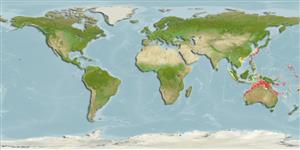Teleostei (teleosts) >
Gobiiformes (Gobies) >
Gobiidae (Gobies) > Gobiinae
Etymology: larsonae: Named for Helen K. Larson.
Eponymy: Susan Lee Jewett (formerly Susan J Karnella) (d: 1945). (Also see Jewett & Susan (Jewett)). In the genus’ name, ‘Sue’ is attached to Eviota, a related genus. Dr Helen K Larson was Curator of Fishes, Museum and Art Gallery of the Northern Territory, Darwin, Australia (1981–2009), retiring as Emeritus Curator, and is now a Research Associate at the Museum of Tropical Queensland, Townsville. [...] (Ref. 128868), visit book page.
More on authors: Winterbottom & Hoese.
Environment: milieu / climate zone / depth range / distribution range
Ecology
Marine; demersal; depth range 40 - 82 m (Ref. 39927). Tropical
Western Central Pacific: northwestern Australia and the South China Sea; undoubtedly widespread.
Size / Weight / Age
Maturity: Lm ? range ? - ? cm
Max length : 2.2 cm SL male/unsexed; (Ref. 39927)
Short description
Identification keys | Morphology | Morphometrics
Dorsal spines (total): 7; Dorsal soft rays (total): 8 - 10; Anal spines: 1; Anal soft rays: 7 - 8. Second dorsal usually with 1 spine and 9 soft rays; first dorsal spine filamentous, reaching near end of second dorsal fin. Pectoral fin 17-19 (rarely 17). Pelvic fin with complete basal membrane and a fraenum, forming a typical gobiid cup-shaped disc. Anterior nasal tube short, 5.7- 7% HL; distal quarter of tube black. Pores present: a posterior nasal, an anterior and a posterior interorbital, a postocular, an infraorbital and 2 preoperculars. Midline of belly naked (Ref. 39927).
Known from dredge and trawl samples, from areas with encrusting invertebrates (e.g. sponges) (Ref. 39927).
Life cycle and mating behavior
Maturity | Reproduction | Spawning | Eggs | Fecundity | Larvae
Winterbottom, R. and D.F. Hoese, 1998. A new genus and four new species of fishes from the Indo-West Pacific (Pisces; Perciformes; Gobiidae), with comments on relationships. R. Ont. Mus. Life Sci. Occas. Pap. (37):1-17. (Ref. 39927)
IUCN Red List Status (Ref. 130435: Version 2024-2)
Threat to humans
Harmless
Human uses
Fisheries: of no interest
Tools
Special reports
Download XML
Internet sources
Estimates based on models
Preferred temperature (Ref.
123201): 23.3 - 28.2, mean 27.3 °C (based on 118 cells).
Phylogenetic diversity index (Ref.
82804): PD
50 = 0.5078 [Uniqueness, from 0.5 = low to 2.0 = high].
Bayesian length-weight: a=0.01023 (0.00477 - 0.02194), b=3.01 (2.83 - 3.19), in cm total length, based on LWR estimates for this (Sub)family-body shape (Ref.
93245).
Trophic level (Ref.
69278): 3.1 ±0.3 se; based on size and trophs of closest relatives
Resilience (Ref.
120179): Low, minimum population doubling time 4.5 - 14 years (Assumed Fec < 100).
Fishing Vulnerability (Ref.
59153): Low vulnerability (10 of 100).
